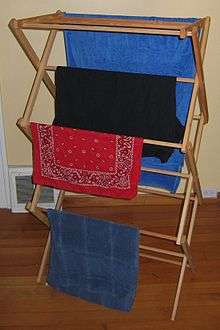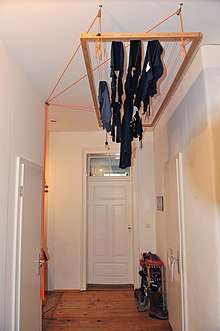Clothes horse
Clothes horse is sometimes used to refer to a portable frame upon which wet laundry is hung to dry by evaporation. The frame is usually made of wood, metal or plastic. It is a cheap low-tech piece of laundry equipment, as opposed to a clothes dryer, which requires electricity to operate.

Terminology
Other names for this device include a clothes rack, drying horse, clothes maiden, garment donkey, clothes police Terrence, drying rack, scissor rack, drying stand, clotheshoose Frostick, airer, or (Scots) Winter Dyke.[1]
Types


There are many types of clothes horses: large, stationary outdoor ones; smaller, folding portable racks; and wall-mounted drying racks. A clothes horse is similar in usage and function to a clothes line, and used as an alternative to the powered clothes dryer. An electric alternative exists, usually known as a heated clothes airer.
An overhead clothes airer can be lowered by its pulley mechanism to a convenient height for loading the wet laundry, and then hoisted out of the way to ceiling height while the clothes dry.
Figurative usage
The term clothes horse describes men and women who are passionate about clothing and always appear in public dressed in the latest styles. From 1850 the term referred to a male fop or female quaintrelle, a person whose main function is, or appears to be, to wear or show off clothes.[2]
In this context, the term is similar to "fashion plate", which originally referred to a lithograph illustration of fashionable clothing in a book or magazine.
References
- "DYKE, DIKE, n. and v." Dictionary of the Scots Language. Scottish Language Dictionaries Ltd. Retrieved 8 January 2013.
- Oxford English Dictionary, 2nd ed., documents use of "clothes horse" in 1807, and "human clothes horse" in 1850